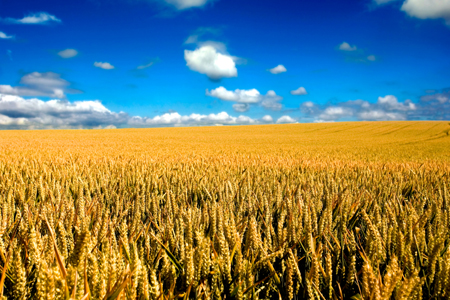Area wheat harvest fares well
Category: Grains
 (AgWeek) – Farmers in the Upper Midwest were pleased this spring when good weather allowed them to plant wheat and barley earlier than usual. They’re even more pleased now.
(AgWeek) – Farmers in the Upper Midwest were pleased this spring when good weather allowed them to plant wheat and barley earlier than usual. They’re even more pleased now.
Yields of newly harvested fields are better than expected after a summer of drought. The early planting allowed the area’s small grains to reach maturity sooner than normal, sparing crops from the drought’s worst effects, farmers and commodity group officials say.
“The good and early spring really saved us,” says Aaron Kjelland, a Park River, N.D., farmer.
He expects “reasonably good” yields with excellent quality from his spring wheat crop, which he’s beginning to harvest.
Officials across the region also stress the importance of early planting this year.
“Getting the crop in early really helped,” says Marv Zutz, executive director of the Minnesota Barley Growers Association, based in Red Lake Falls. “We’re looking at above-average yields with good quality.”
Because the area’s wheat and barley were planted so early, the crops generally are being harvested about two weeks earlier than usual. Minnesota’s barley harvest was wrapping up in late July, normally the time it begins in earnest. Most of the state’s barley will qualify as malting barley, which is used to make beer, rather than feed barley, which fetches a lower price and is fed to livestock.
Heavy, frequent rains in the past few growing seasons often hurt barley’s quality and caused it to make the lower-paying feed grade.
Crops vary within states
South Dakota’s spring wheat harvest, which was on the home stretch in early August, has gone well, says Randy Englund, executive director of the South Dakota Wheat Commission, based in Pierre.
Yields vary sharply across the state, but on balance are about average, while quality is good, he says.
Montana’s small grains harvest was just getting under way in late July.
The outlook varies greatly across the state, says Lola Raska, executive vice president of the Montana Grain Growers Association, based in Great Falls.
Many fields in southern Montana were hurt by too little moisture, while crops in the northern part of the state received more rain and fared better, she says.
Montana and South Dakota typically rank among top five states in spring wheat production. Montana typically ranks among the top three in barley production.
Rebound in North Dakota
North Dakota’s spring wheat, durum and barley crops look much better than they did a year ago.
The state typically ranks first in the production of all three crops. North Dakota fell behind Idaho in barley production in 2011, reflecting widespread planting problems in North Dakota. But barley acreage soared in North Dakota this year and the state is expected to retake the top spot.
Most of North Dakota’s durum is grown in the northwest part of the state, which was hit with heavy rains last spring. The state’s durum crop is much better this year, says Jim Peterson, marketing director of the North Dakota Wheat Commission, based in Mandan.
About a quarter of the state’s spring wheat crop was harvested by late July. On balance, the crop looks good, although wheat in some areas was hurt by drought or hail or both, Peterson says.
“I think most farmers who grew wheat are glad they had it,” he says.
Because there’s so much good-quality wheat this year, it’s unlikely farmers will receive premiums for high-protein wheat, commodity officials say.
Disease, plant roots
The spring wheat harvest has gone well in Minnesota, which typically ranks among the top 10 in spring wheat production.
Roughly half of Minnesota’s spring wheat was combined by late July and most of the rest will be harvested in the next week or so, weather permitting, says Dave Torgerson, executive director of the Minnesota Association of Wheat Growers, based in Red Lake Falls.
He estimated the state’s spring wheat crop will average about 55 to 60 bushels per acre.
“It’s a pretty good crop, better than we expected a few weeks ago,” he says.
Wheat suffered from very little crop disease this growing season, which wasn’t the case in recent wet years, he says.
Wheat plants also benefitted from a normal, healthy root system this growing season, he says. In unusually wet years, wheat roots sometimes don’t develop normally.
Other crops need rain
Bill Farrell, a Larimore, N.D., farmer completed his wheat harvest on July 31.
“We were done in July. I don’t know if that’s ever happened before,” says Farrell, who began farming in 1975.
His wheat had above-average yields and excellent quality.
With wheat out of the way, Farrell is hoping for rain. His other crops, particularly corn and soybeans, need rain. Even his dry, edible beans, which he expects to start harvesting in about three weeks, would benefit from rain, provided it comes quickly.
Most of the Upper Midwest is abnormally dry or in drought, according to the U.S. Drought Monitor, a partnership of federal and academic scientists.
Pastures nationwide have been hurt by drought. Nationally, 57 percent were in poor or very poor condition.
In South Dakota, 61 percent of pastureland ranked poor or very poor. That description applied to 55 percent of pastures in Montana, 38 percent of pastures in North Dakota and 36 percent of pastures in Minnesota.




